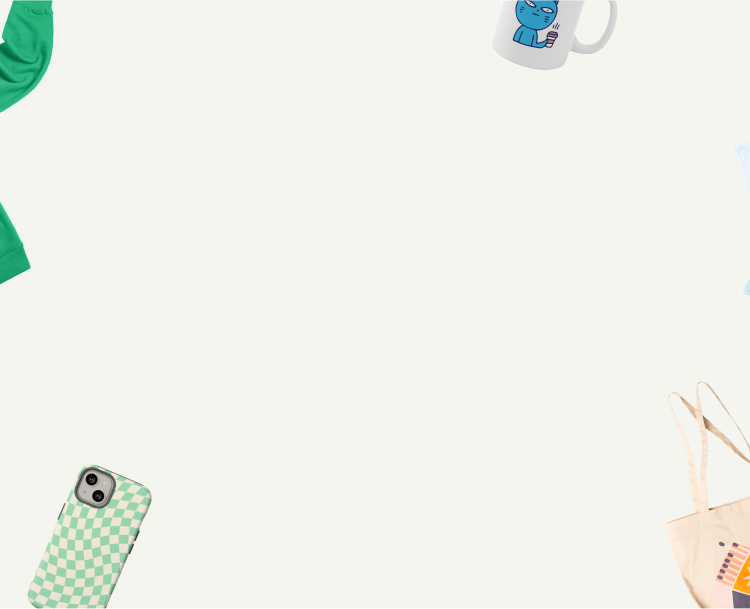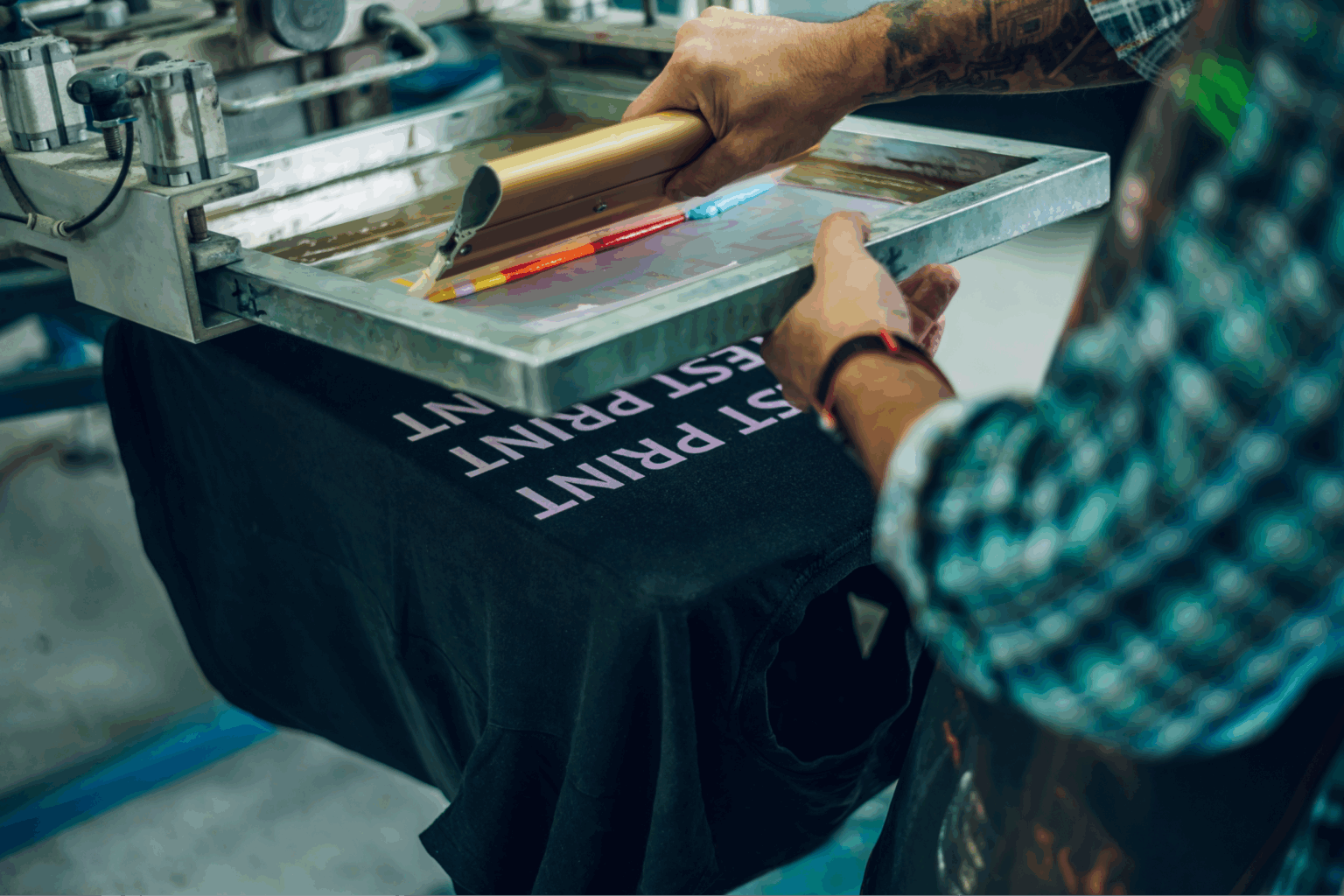How to make shirts at home: A guide to creating your own custom t-shirt
From dye sublimation to heat-transfer vinyl printing and more – learn how to make t-shirts at home and dominate the t-shirt printing industry.
Turn your ideas into profits with Printify
Start your own print-on-demand business and make money while you sleep – no inventory, no hassle.




Your business, your way – sell with Printify
Choosing between Print on Demand vs do-it-yourself printing comes down to how you prefer to run your business.
Print on Demand keeps things simple with low startup costs and a hands-off workflow, while do-it-yourself printing requires more money, time, and technical work upfront.
Not sure which model fits your goals? We’ll break it all down so you can make the right call.
Print on Demand (POD) is a business model where you can sell custom products online without storing inventory or managing logistics. You partner with a POD company that prints and ships each product on demand after a customer orders.
Do-it-yourself (DIY) printing means you produce every item using your own equipment. In other words, you handle the entire production process yourself in-house.
Before choosing Print on Demand vs do-it-yourself printing, it’s important to understand each method’s costs, workflow, and growth potential.

Print on Demand: Low upfront costs, faster to launch
With POD, there’s no need to purchase equipment, blank shirts, or storage space. Every order happens on demand, keeping your overhead costs low.
Here’s how the money flows when you sell custom products online with Printify:
Want even cheaper base costs? Upgrade to Printify Premium to get up to 20% discounts on products.
Do-it-yourself: Higher upfront costs, long-term payoff
DIY printing requires a sizable initial investment because you’re building a production setup from scratch.
To illustrate, let’s look at the general cost of printing t-shirts at home with direct-to-garment (DTG). You will need:
Altogether, sellers can spend between $8,000–$10,000 upfront – not counting ongoing costs like design software or storage. For context, Printify seller George McConnell previously spent $10,000 per month just on warehousing when running a DIY operation.
A DTG/DTF printer can typically produce 100-200 shirts per month, bringing the per-shirt cost to about $8–$12, depending on ink coverage and blank quality. This number is comparable to Printify’s prices.
Besides the upfront costs, you also have to consider the time investment. Learning how to run the entire operation yourself takes practice.
Print on Demand: Simpler pricing, slimmer margins to start
POD margins depend on the product’s base cost plus the retail price you set.
For example, selling a Gildan 64000 Unisex Softstyle T-Shirt for $20 through Printify would look like:
Since you’re working with the provider’s pricing structure, your margins are typically slimmer, especially after accounting for third-party fees – like your online store subscription, payment processing, taxes, and so on.
On average, POD sellers reach their first $1,000 in revenue in about 165 days.
The trade-off? Minimal risk, as you only pay for production costs when someone buys.
This model has helped sellers like Emily Odio-Sutton grow their Printify shops into six-figure businesses, proving the margins can work when paired with strong designs and marketing.
Do-it-yourself: Better profit margins, but slower to recoup costs
Once a DIY setup is running, your per-item material costs drop. Using the same $20 retail price example and an estimated $7 cost per shirt, your numbers would be:
Costs can drop even further if you buy blanks in bulk, negotiate with suppliers, or optimize ink usage.
On paper, this gives you better profit margins than POD. However, this scenario only becomes realistic after your business grows and has sold enough products to offset the initial costs, which takes time.
Print on Demand: Hands-off workflow on the provider’s timeline
With POD, the entire production process happens in the background, freeing you to focus on design, marketing, and customer communication.
Timelines depend on the Print Provider, but platforms like Printify keep things transparent by showing average production times on every product page. This way, sellers know what to expect before adding an item to their print-on-demand stores.
If a provider experiences delays or runs out of stock, Printify’s Order Routing automatically sends the order to another Print Provider to keep fulfillment on track.
Do-it-yourself: Faster production, but more hands-on work
DIY printing gives you higher control of the production timeline. The moment an order comes in, you can start printing immediately without waiting for a third party.
However, you’re responsible for pre-treating, printing, curing, and handling packaging. A few shirts are manageable, but higher volumes require more time and eventually extra help to maintain efficient operations.
Printify supports bulk order printing, so you can outsource high-volume runs when needed – even if you normally print in-house.

Print on Demand: Quality depends on your Print Provider
When using POD, you don’t personally inspect each item before it ships, so consistency comes down to the Print Provider. That said, Printify lets you order samples to check print quality, fabric feel, and color accuracy before adding items to your product offerings.
Sellers can also use Printify Choice, which automatically selects the top-rated Print Provider for each order. Prefer choosing manually? Easily check their performance data – including quality, production speed, and shipping reliability.
Behind the scenes, Printify’s Print Providers follow multiple quality checks before an order goes out to maintain consistent standards.
Do-it-yourself: Full control, but harder to maintain at scale
DIY printing provides greater control over the product quality. From color profiles to print density, you can adjust everything until every item looks exactly right.
But consistency becomes tougher to maintain when you get orders in large quantities. The job of printing and inspecting all falls on you, and unlike POD, any mistake is yours to fix.

Print on Demand: Hands-free fulfillment
POD handles the entire backend, so you have little control over what happens in the background.
However, Printify makes shipping easy to track by showing delivery estimates and costs for every product. And with a worldwide network of Print Providers, you can reach a global audience without running an expensive international operation.
Many products also support Express or Priority Shipping, giving customers faster delivery options.
While packaging is mostly standardized, Printify offers branded neck labels and packaging inserts to strengthen your brand.
Do-it-yourself: Full freedom and responsibility
In DIY printing, you decide how to store blank products, organize finished items, manage packaging supplies, and prepare shipments. Temperature, space, humidity, and inventory systems all matter once you start producing regularly.
You’ll also handle label printing, packing orders, scheduling pickups, and making post office runs.
The upside is complete control over the unboxing experience – custom wraps, themed packaging, handwritten notes, or anything that fits your brand.
Print on Demand: Easy to scale without slowing down
POD lets you scale quickly without increasing your workload. Sellers can add new designs, test multiple products, or launch seasonal items without buying extra space or recruiting help.
When orders spike, your POD partner handles the increased volume – no late-night printing or scrambling for materials.
Do-it-yourself: Scalable with more resources
DIY can grow, but each jump in sales adds workload. More orders mean more printing, curing, organizing, and shipping. Eventually, you’ll need a bigger workspace, upgraded equipment, or extra hands just to keep up.
It’s rewarding if you love the craft, but expansion takes time, structure, and additional investment.
Here’s how Print on Demand vs do-it-yourself compare at a glance.
| Feature | POD | DIY |
|---|---|---|
| Startup costs | Low – only pay after a customer orders. | High – equipment, materials, and workspace needed upfront. |
| Profit margins | Slimmer margins due to higher per-unit costs. | Higher margins once equipment is paid off. |
| Production workload | None – printing is handled for you. | High – you manage the entire production process. |
| Quality and consistency | Depends on the Print Provider, but samples help verify quality. | Full creative control, but consistency is harder at high volumes. |
| Fulfillment and logistics | Fully handled – packaging, inventory, and shipping are automated. | Manual – packaging, inventory, and shipping are your responsibility. |
| Scalability | Easy to scale without extra labor or space. | Slower to scale and requires more space and equipment. |

Now that you know the differences between Print on Demand vs do-it-yourself printing, here’s a quick way to decide which model actually fits your goals.
Choose Print on Demand if you:
DIY is the right business model for those who:

Starting a POD business is easy with Printify. Go from a design idea to a live product in just a few steps – no equipment, no inventory, no stress.
Create a free Printify account and browse our Catalog of over 1,300 products – from t-shirts and hoodies to mugs and accessories.
Use our Product Creator to upload your artwork, build designs with AI, or explore our graphics library. Use Printify Trends to discover what’s selling right now and generate AI visuals inspired by the latest styles.
Printify integrates with major eCommerce platforms like Shopify, Etsy, Amazon, eBay, and more. Publish your products in a few clicks and start selling immediately.
Whenever an order comes in, we handle the printing, packing, and shipping, while you focus on growing your brand.
The biggest downsides are higher per-unit costs and less control over production. Since items are made one at a time, margins can be smaller, and you depend on the Print Provider’s speed and consistency.
For beginners, the trade-off is worth it because you avoid equipment, storage, and upfront inventory. Plus, you get to set your own profit margins.
The success of print-on-demand stores varies depending on your niche, marketing strategy, and product quality. Printify supports over 10 million merchants who have built profitable shops. Curious how they did it? Read up on their success stories.
No, many beginners start as sole proprietors. Forming an LLC depends on how you prefer to separate your personal and business finances. Always check local regulations or speak with a tax professional for guidance.
Read our article on whether you need a business license to sell on sites like Etsy for more information.
If you already own printing equipment, DIY printing can be cheaper per unit. Otherwise, Print on Demand is more affordable because you skip equipment costs entirely.
With Printify, you only pay for production when a customer places an order, making it the lowest-risk option for beginners.
Choosing between Print on Demand vs do-it-yourself printing depends on how you prefer to run your business and where you want to invest your time.
Ready to sell custom products without hassle? Start designing with Printify.
Open your business today: Create and sell beautiful custom-products within minutes. Printify prints, and delivers 1,300+ products at the lowest prices around. No risk, all reward.
100% free · Easy to use · 1,300+ products